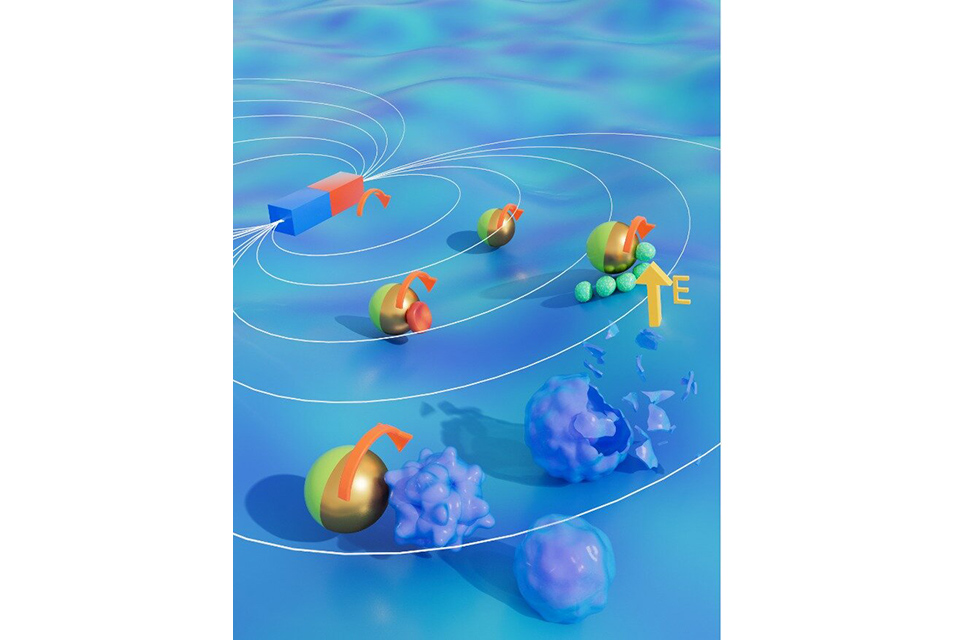TEL AVIV.- Researchers at
Tel Aviv University have developed a hybrid micro-robot, the size of a single biological cell (about 10 microns across), that can be controlled and navigated using two different mechanisms—electric and magnetic. The micro-robot is able to navigate between different cells in a biological sample, distinguish between different types of cells, identify whether they are healthy or dying, and then transport the desired cell for further study, such as genetic analysis.
The micro-robot can also transfect a drug and/or gene into the captured targeted single cell. According to the researchers, the development may help promote research in the important field of single-cell analysis, as well as find use in medical diagnosis, drug transport and screening, surgery, and environmental protection.
The innovative technology was developed by Prof. Gilad Yossifon from the School of Mechanical Engineering and Department of Biomedical Engineering at Tel Aviv University and his team: Post-doctoral researcher Dr. Yue Wu and student Sivan Yakov, in collaboration with Dr. Afu Fu, Post-doctoral researcher, from the Technion, Israel Institute of Technology. The research was published in the journal Advanced Science.
Prof. Gilad Yossifon explains that micro-robots (sometimes called micro-motors or active particles) are tiny synthetic particles the size of a biological cell, which can move from place to place and perform various actions (for example: collection of synthetic or biological cargo) autonomously or through external control by an operator.
According to Prof. Yossifon, "Developing the micro-robot's ability to move autonomously was inspired by biological micro-swimmers, such as bacteria and sperm cells. This is an innovative area of research that is developing rapidly, with a wide variety of uses in fields such as medicine and the environment, as well as a research tool."
As a demonstration of the capabilities of the micro-robot the researchers used it to capture single blood and cancer cells and a single bacterium, and showed that it is able to distinguish between cells with different levels of viability, such as a healthy cell, a cell damaged by a drug, or a cell that is dying or dying in a natural "suicide" process (such a distinction may be significant, for example, when developing anti-cancer drugs).
After identifying the desired cell, the micro-robot captured it and moved the cell to where it could be further analyzed. Another important innovation is the ability of the micro-robot to identify target cells that are not labeled—the micro-robot identifies the type of cell and its condition (such as degree of health) using a built-in sensing mechanism based on the cell's unique electrical properties.
Prof. Yossifon states, "Our new development significantly advances the technology in two main aspects: hybrid propulsion and navigation by two different mechanisms—electric and magnetic. In addition, the micro-robot has an improved ability to identify and capture a single cell, without the need for tagging, for local testing or retrieval and transport to an external instrument. This research was carried out on biological samples in the laboratory for in-vitro assays, but the intention is to develop in the future micro-robots that will also work inside the body—for example, as effective drug carriers that can be precisely guided to the target."
The researchers explain that the hybrid propulsion mechanism of the micro-robot is of particular importance in physiological environments, such as found in liquid biopsies. "The micro-robots that have operated until now based on an electrical guiding mechanism were not effective in certain environments characterized by relatively high electrical conductivity, such as a physiological environment, where the electric drive is less effective. This is where the complementary magnetic mechanism come into play, which is very effective regardless of the electrical conductivity of the environment."
Prof. Yossifon concludes, "In our research, we developed an innovative micro-robot with important capabilities that significantly contribute to the field: hybrid propulsion and navigation through a combination of electric and magnetic fields, as well as the ability to identify, capture, and transport a single cell from place to place in a physiological environment. These capabilities are relevant for a wide variety of applications as well as for research.
"Among other things, the technology will support the following areas: medical diagnosis at the single cell level, introducing drugs or genes into cells, genetic editing, carrying drugs to their destination inside the body, cleaning the environment from polluting particles, drug development, and creating a 'laboratory on a particle'—a microscopic laboratory designed to carry out diagnostics in places accessible only to micro-particles."










